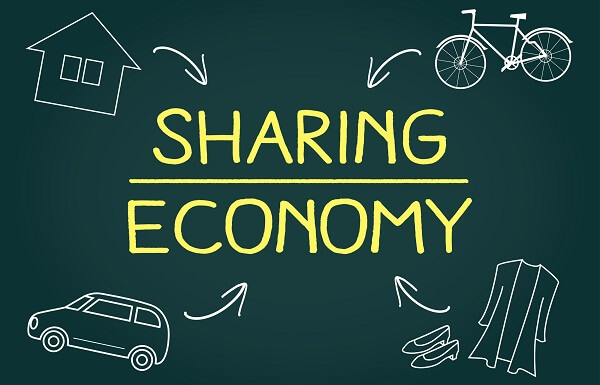Amid the coronavirus turmoil that affected the entire world, re-examination of working styles has begun, such as the spread of telework in Japan.
Coupled with such a situation, the keyword “Gig Economy” is being used more and more recently.
So this time, what is the gig economy? What are the benefits for engineers? Introducing such things.
table of contents
- 1. What is the gig economy?
- 2. About the advantages and disadvantages of the gig economy
- 3. Industries / fields where the gig economy spreads
- 4. Gig economy in Japan
- 5. Gig Economy and Engineer
- 6. Summary
1. What is the gig economy?

Gig economy means a form of work (economic activity) in which work is ordered and received on a business-by-business basis using the Internet. People who work in the gig economy are sometimes called gig workers.
Generally, it is realized by matching companies that want to secure human resources in projects, freelancers who want to utilize their skills and time, sole proprietors, and office workers who can work side jobs .
Uber Eats, for example, is one of the gig-economy ways of working, where you get the delivery fee by delivering in your spare time.
Gig is a term originally used to refer to a one-off live concert performed by a musician at a live house. The work style in which one-off work such as such a session is ordered and placed on the Internet is called the gig economy.
Here, we will introduce the advantages and disadvantages of the gig economy, changes in working styles, and so on.
1.1 Background of the expanding gig economy

Due to changes in social conditions and the evolution of the Internet and technology, the way we work and work has changed dramatically.
Companies are not only hiring employees to do their jobs, but are also taking advantage of non-regular workers, external companies, and freelance outsourcing.
Not only are workers working as full-time employees, but more and more people are doing side jobs and becoming freelancers seeking free working styles. In addition, the number of people who want to work while giving birth, raising children, and providing long-term care is increasing, and there is also a trend to effectively utilize the power of such people.
Underpinning this situation is the evolution of the Internet and technology, which makes it possible to work by telework or remote work without going to the office. Furthermore, the number of platforms that can place and receive jobs on the Internet is increasing, and it is becoming possible to match companies that want to place orders with workers who want to utilize their skills .
In addition to these factors, such as the labor shortage and the aging of society in recent years, expectations for the gig economy are increasing.
1.2 Characteristics of working styles of gig economy

Whereas the traditional way of working is to come to work at a fixed time and do a fixed job, in the gig economy, it is a work style that decides the work and time by yourself. Here are some of the characteristics of working styles in the gig economy.
■ Not obliged to go to work
Basically, remote work is not obliged to go to work and do business. However, depending on the content of the work, there are cases where the ordering party (or intermediary) prepares the working environment so that it can be used freely.
■ Workers choose according to their work style
You can choose your own work by taking advantage of your free time. It is also easy for office workers to use it at their own convenience, such as after work, on holidays, and by taking advantage of the time between child-rearing.
■ Get work using the Internet
A platform such as an intermediary connects a company that wants to order a job with a gig worker who wants to receive an order. You can search for a job using a specialized site or app, so you can ask for or receive a job without any special connections or connections.
■ The contract form is basically outsourcing
Most contracts for working in the gig economy are basically outsourced rather than employment. It is a form of earning a reward by completing the work undertaken. Depending on the contract, even if you do not complete the work, you may end it when you finish the work within the range you decided. However, unlike office workers, they are not subject to work-related accidents or social security, so they must manage their own risks.
1.3 Work styles compared to the gig economy

The gig economy is a relatively new concept and has no clear definition. Similar concepts include the sharing economy and crowdsourcing. Let’s understand these differences.
■ Differences from the sharing economy
The gig economy shares people’s skills and time.
For example, you can use the skills of a programmer in a project of company A, and when the work is finished, you can use it in a project of company B.
Use your skills in the work of various companies.
On the other hand, the sharing economy is a service that rents out or mediates personally owned assets such as vehicles and housing. It is a system in which users share (share) things (locations, services, etc.) that they are not using. Airbnb , which offers private housing as accommodation, is a well- known example of its success.
The difference is that the gig economy focuses on the way people work, and the sharing economy focuses on things .
■ Difference from crowdsourcing
Crowdsourcing provides a place for businesses to provide jobs and workers to provide skills.
This belongs to the concept of gig economy.
It is used as an outsourcing platform to connect companies and individuals.
However, it is a platform for people with specific skills such as programming, web design, and illustration.
Gig economy refers to the economic activity of ordering and ordering one-off jobs via the Internet, so crowdsourcing can be said to be a part of this service .
2. About the advantages and disadvantages of the gig economy

What are the advantages of the gig economy over traditional employment and working styles? In the conventional working style framework, there are merits for both the company side and the working side, such as being able to utilize the skills of human resources who could not work and being able to work in a way that suits each lifestyle. Of course, there are also disadvantages. Here, let’s examine the advantages and disadvantages of each.
2.1 Advantages and disadvantages for workers

■ Benefits
You can work flexibly according to your lifestyle. Especially for those who have time constraints such as childcare and long-term care, the gap time can be used effectively .
Those who have the skills will be able to promote their skills widely and will be more likely to be properly evaluated. The higher your skills, the more chances you have of higher rewards.
You can choose an environment that is comfortable for you. It is possible to work intensively in a short period of time and have a lot of hobbies and family time, so that you can improve your work-life balance .
■ Disadvantages
Your income may not be stable and your life may become unstable, such as when you have a job and when you do not have a job .
In most cases, benefits, workers’ accident compensation, social insurance, etc. are not available. If you are unable to work due to illness or injury, you need to manage the risk yourself .
If you don’t have enough skills, you tend to have less work or lower rewards. Also, depending on the job content, the competition rate of gig workers is high, and it may not be possible to get enough jobs.
In the event of any trouble or problem, the individual who undertakes the work will take responsibility (depending on the contract). In some cases, you may be required to pay large damages.
2.2 Advantages and disadvantages for companies

■ Benefits
Even if there is a shortage of labor, you can request a job on a one-off basis, so compared to hiring a full-time employee, you can reduce fixed costs such as monthly salary and social security that are required throughout the year.
We will secure human resources who are ready to work when needed, so we will not spend the cost and time required for human resource development .
Compared to outsourcing to a company, it is cheaper to outsource the work to a freelancer. From many gig workers, you can choose the person who meets your company’s conditions by looking at past achievements.
■ Disadvantages
Often the work is concentrated on skilled gig workers, so it’s not always possible to get the people you want to order when you need them.
It is possible that we cannot secure suitable human resources and place an order with a worker with low skills, resulting in an increase in labor such as rework.
By relying on an external gig worker each time, we may not be able to accumulate knowledge and skills within the company, and as a result, we may not be able to set out an advantage over other companies.
The work enhances the personality of the individual, such as the quality of the ordered deliverables and the sense of responsibility for the delivery date. Different people can have completely different results .
3. Industries / fields where the gig economy spreads
Gig economy is widespread in many areas where companies outsource their operations. For example, the demand for professionals such as sales, accounting and accounting, software development, and creative is high, and the workforce of gig workers is active .
There are also more jobs that can be done without having such special skills, a prime example of which is Uber Eats. In the city center, I often see bicycles carrying Uber Eats backpacks. The use of the gig economy is also attracting attention in the construction field, where labor shortages are significant . Let’s take a look at a typical example of the gig economy.
3.1 Typical example of gig economy
■ Uber Eats
>>Uber Eats
Uber Eats, which undertakes food delivery on bicycles and motorcycles, is one example of a successful gig economy in Japan.
It is a system that delivers ordered products instead of restaurants using bicycles and motorcycles that you have prepared yourself.
・ Customers: More restaurants can order delivery and enjoy it
・ Delivery staff: Work at your favorite time and get rewards
As you can see, there are many merits, and the use of this service is expanding rapidly, especially in central Tokyo.
The problem is that the delivery person is not hired by Uber, but works outsourced, so even if an accident occurs, work accidents are not applied and you have to handle it yourself. That is.
In addition, proper delivery depends on the skill and morals of the delivery person, so customer complaints are sometimes talked about.
But Uber Eats is currently the most major success story.
■ Lancers
>>Lancers
Lancers is a platform that allows you to place orders for specific skills such as homepage creation, application development, logo design, and writing .
It is one of the largest systems in Japan with more than 1 million registrants and a cumulative total of over 200 billion yen requested by companies.
Anyone can easily register as a gig worker even if they have little experience, and it will be easy to jump into a side job for the first time.
However, there are many projects where the amount of compensation is very low.
On the corporate side, you can place orders at low cost and reduce costs.
The problem is that there are many fairly inexpensive projects, and it is difficult for gig workers to get good deals until they have achieved some achievements.
From the corporate side, it is difficult to determine the quality of gig workers, and quality concerns remain until the deliverables come out.
It’s difficult to find a good match in terms of price and quality, but it’s a successful gig economy in that such a large platform has been established and established.
4. Gig economy in Japan

The population of the gig economy is said to exceed 50 million in the United States, and many services for the gig economy have been created.
The gig economy is not so widespread in Japan.
Moreover, many Japanese companies mainly deal in BtoB, and there are not many transactions with individuals.
However, as outsourcing has become more active in recent years, outsourcing to external companies and freelancers has increased, and the door to transactions with individuals has gradually opened up. With the recognition of the existence of matching sites such as
Lancers and Coconala , a foothold for the spread of the gig economy is being established .
According to a survey by the Cabinet Office , the number of freelancers in Japan will be about 3 million in 2019, and it is estimated that the number will continue to increase steadily due to the flow of work style reforms.
Furthermore, the number of companies that lift the ban on side businesses is increasing, and the number of large companies and venture companies that accept side businesses is increasing.
From this social trend, the spread of the gig economy will surely spread in Japan as well.

5. Gig Economy and Engineer

For engineers who can work remotely and anywhere, the gig economy is a very compatible system .
In fact, in the United States and other countries, borderless work styles that transcend national boundaries are advancing, such as utilizing engineers from emerging countries and Eastern Europe for remote work.
In the United States, we have a track record of getting very high compensation, especially in industries that require skills.
Below is an hourly wage conversion of work-specific compensation from a FitSmall Business survey.
2. Blockchain architecture ($ 87.05 / hour)
3. Robotics ($ 77.46 / hour)
4. Estical hacker ($ 66.33 / hour)
5. Cryptocurrency ( $ 65.37 / hour) /Time)
Source: 10 Highest Paying Gig Economy Jobs of 2018
In areas that require a high degree of specialization and skill, we are getting quite high compensation.
We haven’t seen such a fact-finding survey in Japan yet, but with the spread of the gig economy, some occupations will eventually be able to earn high compensation.
6. Summary

In the future, the gig economy will become widespread in Japan, and the number of people who want to work as gig workers will increase. If you make good use of your skills and time, you will not be bound by the company and you will be able to build a better life-work balance.
However, the gig economy is by no means a rosy way of working. Instead of choosing your time and lifestyle, you sacrifice stability and security. Risk management and self-management are very important.
Engineers have a high affinity with the gig economy, so I want to make good use of the coming era of the gig economy. To that end, I would like to make efforts to improve my specialty and skills.

